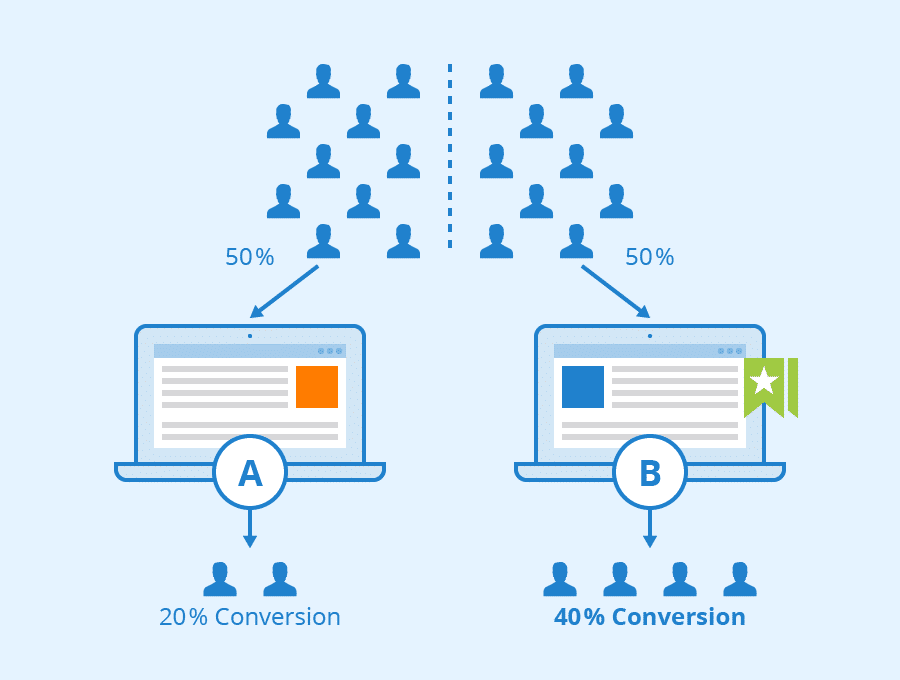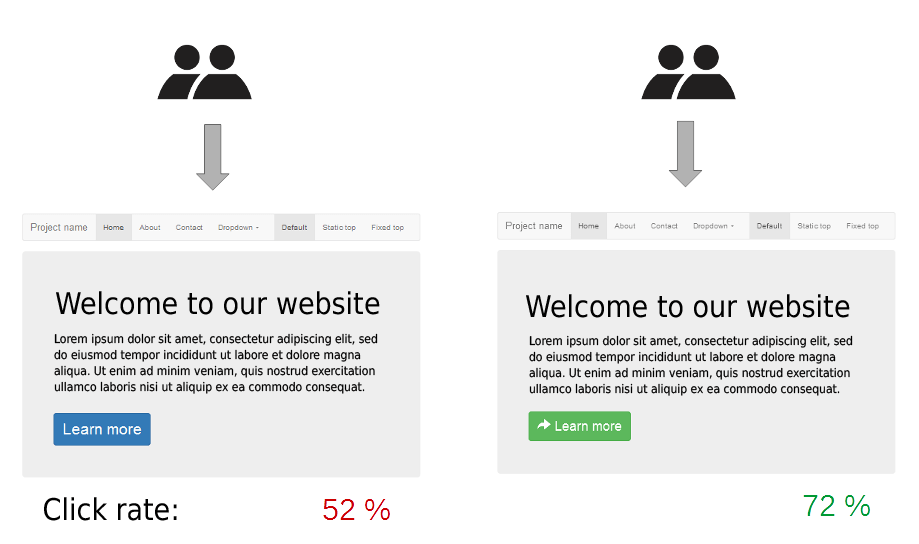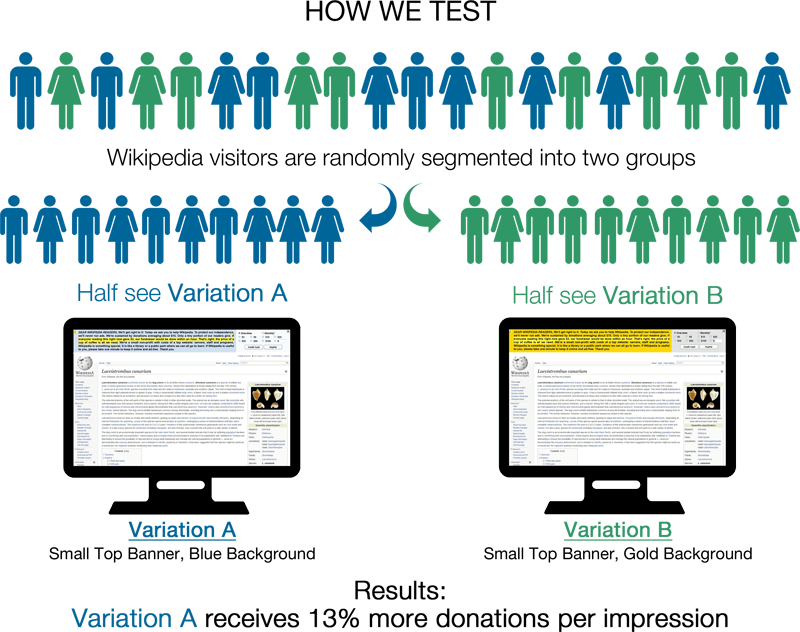
Key Takeaways for you
| – A/B testing helps to improve website user experience by identifying and solving pain points. – It reduces the bounce rate by providing the best version of your website to your audience. – A/B testing enables low-risk modifications by making minor changes to webpages instead of revamping the entire webpage. – A/B testing allows you to test and launch new features based on data-driven results instead of “assumptions” – It is useful for high-traffic websites with many pages that have the same template. – There are different types of A/B testing including A and B testing, split URL testing, multivariate testing, and multi-page testing. |
Out of the millions of web pages crowding the internet space, how do you beat your competitors and rise above them?
Only a miracle can do the trick. Or maybe magic?
Wrong!
The truth is in the right SEO strategy. SEO is engineering. SEO is science.
You run experiments, collect data, analyse the data, and run some more experiments until you get the best results.
A/B testing is one such experiment which helps you narrow down and understand the effectiveness of your optimization practices.
Can A/B testing be used in the SEO context? Why is it useful and what are the elements for testing? Read more to understand this and more.
What is A/B testing in SEO?
It is simple. You have sample A and sample B. You give A to one set of audience and B to another. Then you determine the responses of the audience to both A and B. You use the more effective sample between the two for marketing.
A/B testing in SEO is the process of deploying multiple versions of a webpage to different users at the same time and checking the before and after effects to make data-backed decisions. The end goal is to increase visibility in the Search Engine Results Pages and achieve higher rankings and increase organic sessions.
The different versions of the page help you determine which version has the most impact on users and drives more traffic. It is a way for site owners to understand whether the optimisation methods employed by them are working positively.
However, not all websites are suitable for A/B testing. The primary requirements for A/B testing are:
- High-traffic websites, and
- Websites with a lot of pages with the same template.
The different types of websites that can employ A/B testing are:
- E-commerce
- Travel
- Retail
- Learning
- Publishers
- Listing websites like OLX, eBay
Though this is not an exhaustive list, I hope you get the idea.
The test requires several pages of a website that have the same template and metrics which can be split into two or more batches. Here one batch remains the same which is called a control page, while changes in metrics are implemented on the others and they are called the variant pages.
Types of A/B testing
A and B testing
It is the most basic form of A/B testing where you compare the performance of a single page with one different variant, denoted as A and B respectively. This test is mostly used for smaller sites and is easier to implement.
Split URL testing
This test involves testing an entirely new version of an existing webpage URL for comparative performance analysis. The web traffic is divided between the control and variant pages and the conversion rate for each page is measured to see which is performing better.
Multivariate testing
This experiment involves testing variations of multiple page variables simultaneously to analyse which combination of variables works best. This type of testing is suitable for advanced marketing, product and development professionals.
Multi-Page testing
Multi-page testing consists of testing changes in particular elements across multiple pages.
If you are looking to improve SEO, A/B testing is a great way to start to understand how users engage and interact with the website. Let us see how A/B testing helps SEO
Why should you consider A/B testing?

To understand and solve visitor pain points.
A user may visit your website for various reasons. It may be to know more about a specific topic, to browse the contents, to understand your product or service, or even to purchase the product or service. During the course of their interaction with your website, they may experience some inconveniences to get what they are looking for. For example, they may not be able to navigate freely to the desired pages or may be having trouble finding the CTA button.
This causes a bad user experience and they tend to leave the page. This impacts your conversion rates.
By A/B testing you can track user behaviour on your web pages using tools like heatmaps, Google Analytics and website surveys to solve user pain points.
To reduce the bounce rate
Bounce rate is the most important metric to track if you want to analyse user behaviour. Your website experiences a high bounce rate for different reasons, like when user expectations are not met, there are too many options to choose from, your website is confusing to navigate, and so on.
Since different websites have different goals and cater to different kinds of audiences, there is no single solution to reduce the bounce rate. This is where you can use A/B testing. By testing multiple variants of an element on your website, and different combinations of variants, you can identify the best possible version of your website to provide an overall improved version for your users. This enables users to spend more time on your website and possibly convert into a customer.
To improve ROI
The cost of acquiring quality traffic to your website is huge, and there is no denying it. You can use A/B testing to make the most of your existing traffic and increase conversions rather than spending more to acquire fresh traffic. Even the slightest changes to your website can bring about significant results and increase overall business conversions.
To make low-risk modifications
A/B testing helps you utilise your resources for maximum output with minimum modifications to achieve an increase in ROI. You can make minor changes to your webpage using A/B testing instead of changing the entire page, and reduce the risk of jeopardising your current conversion rate.
You can analyse user reaction to changes, by launching new features as an A/B test. By testing and then making changes based on the data collected, you can make the outcome more certain instead of random guesswork.
To achieve data-driven results.
Since A/B testing is entirely based on data, there is no guesswork involved. You can determine what works and what does not base on pure statistics as proof. You can use metrics like time spent by users on the page, click-through rate, cart abandonment rate, etc.
To redesign your website to increase future gains
Once you determine the best possible version of your website using A/B testing, you can redesign your website with that version. It may be from minor colour changes to certain pages to completely revamping your website.
This does not mean you quit testing. User behaviour is forever evolving, and to know the real-time changes, you need to constantly test different web page elements to ensure an optimised user experience.
I have been speaking of “variables” and “elements” in A/B testing. But what are these elements? Anything can be A/B tested for a website. But there are some site elements that influence SEO, and these must be your focus of interest.
What are the best elements for A/B testing?

SEO A/B testing may vary in complexity. I am not going to cover them all. I shall discuss the basic beginner-friendly use cases. Once you are familiar with the simple test elements, you can explore further in this library of case studies for SEO A/B testing. It can be formatting, writing style, headlines, subheadlines, designs and layout.
Title tags
Title tags are crucial from a ranking perspective as they directly influence click-through rates. They are what attract users, forcing them to click open the links. Google has set standards for expected CTR in searches and if your landing pages do not meet these standards, it will negatively impact your chances of ranking.
Meta Descriptions
Meta descriptions, like title tags, directly impact CTR and improving them can significantly bring in more clicks and better rankings. Websites that have keywords ranking in the SERP are already getting a lot of impressions, and A/B testing meta descriptions for them can be really beneficial.
Structured data
Structured data or schema markups to web pages greatly help improve user experience and are a great use case for A/B testing.
Eg. FAQ markup, Breadcrumb markup, and review markup.
Internal linking
Internal links are necessary to communicate the site architecture to search engines. Adding sufficient internal links with the right anchor text can dramatically improve keyword ranking for large websites. You can use A/B testing to find the appropriate anchor texts for your internal links.
Repositioning existing Content on a page.
Good content is always beneficial to your site. Presenting that content in the right manner matters so that visitors can get what they are looking for (and even what they did not know they were looking for). A/B testing enables you to measure whether search engines and users are responding positively to your content.
Most efforts and resources are invested in driving quality traffic that converts. You can only attract your target audience by offering them what they want and the best possible experience when they visit your website.
A/B testing can be used to systematically find out what works and what does not work in a marketing campaign. That brings us to the next question, how to perform SEO A/B testing?
How to perform SEO A/B testing?

The following are some steps to follow for SEO A/B testing.
Pick your testing pages.
First, you must select a group of pages with similar templates for your test. The more the number of pages, the more is your data collected for comparison.
What do similar templates mean?
They are pages with the same layout serving the same purpose, like e-commerce websites selling different products, hotel booking pages, etc.
The pages should have background days for a substantial period of time, preferably a year, so that you know the traffic trend over the course of a year. You can use this data for forecast and analysis.
Create a hypothesis for your A/B test
There is no experiment without a hypothesis. It is the prediction of the results of your experiment. Create a hypothesis for your test based on your goals and decide what you must achieve those results.
Suppose, you want to increase brand visibility and rank in the search results. What would you need to do for that?
You need to increase the relevance of your web pages to search queries. For that, you must improve page content, include relevant keywords, and new and diversified content, and add related multimedia to test your hypothesis. You can also reasonably estimate what kind of traffic you want to attract by making these changes.
Divide the pages into Control and Variant pages
Once you have your hypothesis in place, you separate the pages into control and variants. The criteria for this separation are up to you.
You must refer to previous data to see how the pages have been performing and ensure that each set of pages has the same amount of traffic and follow similar trends.
At the same time, you must keep in mind the external factors that might influence the results. For example, if you have a clothing retail website. There would be seasonal traffic for winter wear and summer wear. You cannot compare the two as control and variants. You must test winter wear separately from summer wear.
Make the modifications
Next, you make modifications to the variant pages while keeping the control page intact. You must have two sets of live pages with two different formats at the same time.
They must be different pages that host different content. If you have different versions of the same page, it will affect the outcome of your test.
Gather data and analyse results
After you have implemented the modifications, give it a reasonable resting time before you start analysing the results. You can then measure the clicks from search, and click-through rate and compare the results for both control and variant pages.
You can follow this on a daily basis and check if the acquired traffic is meeting your expectations.
The test is positive if you can see the following outcomes.
- The traffic trends of the variant pages are substantially higher than the control pages.
- The traffic in variant pages is considerably higher than your predictions.
If you do not see either of the above, then forget about the changes and stick to the original design, or come up with an entirely new strategy.
Conclusion
I hope this article has given you a fair idea about A/B testing. The end goal is to offer a user-friendly, easily accessible, easy-to-navigate website to visitors, acquire more traffic, and convert them to increase sales.
A/B testing is an invaluable method to achieve these results. The most beneficial advantage is you can make decisions backed by data and leave less room for guesswork and gambles. You can identify weak points and eliminate them and create the most optimised version of your page.
Have you tried A/B testing? How effective were your tests?
Let me know in the comments.


